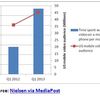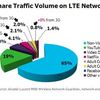Mae Kowalke, TMCnet Contributor
Metro transport networks are in for a rough ride in the next few years if steps are not taken to ameliorate the impending bandwidth challenge they will face.
Metro networks are expected to grow in traffic by 560 percent by 2017, according to a recent Alcatel-Lucent TechZine post, Retool Metro Transport Networks with Packet-Optimized WDM. That’s because, thanks to the cloud and increasing video usage, the percentage of overall network data is increasingly happening in metro networks. In 2012, 57 percent of data traffic terminated in the metro network. By 2017, according to Alcatel-Lucent estimates, 75 percent will terminate in metro networks.
The short-term solution is to add bandwidth through the addition of higher capacity 100G-capable transport systems. But this is only a quick fix.
“Service providers are realizing that current networks are not efficiently filling the 100G pipes with the mix of packet traffic,” noted Alcatel-Lucent’s Dave Brown in the blog, which also has an accompanying metro transport network podcast. “This issue will only exacerbate in the more complex and dynamic nature of metro networks. Some analysts indicate that 100G market adoption is now only at about 10 percent of its peak i.e. it’s the higher volume metro market that will drive 100G to mass market volumes.”
The longer-term solution is leveraging a cloud-optimized metro network approach using integrated packet transport solutions. This packet-optimized WDM approach is more holistic than just adding bandwidth because it is not only scalable but also an agile and efficient network.
A packet-optimized WDM is optimized for scalability with metro-tuned, programmable 100G and 200G options and with multilayer, multiservice switching, and it should use an integrated layer 2 over WDM solution for maximum efficiency and performance, according to Brown.
It also should be MEF Carrier Ethernet (CE) 2.0 certified for all MEF service types – E-Line, E-LAN, E-Tree and E-Access, and be a solution that leverages a proven OS across the optical and Ethernet/IP/MPLS platforms for the benefits of a common service, operational and management model.
With an increasing amount of data terminating within the metro network, adding bandwidth is not enough. The network also must be more agile, taking advantage of the bandwidth it is given.
Whether providers will take the long-term approach or look for a quick fix is still unknown, but the correct solution to the problem is obvious.












